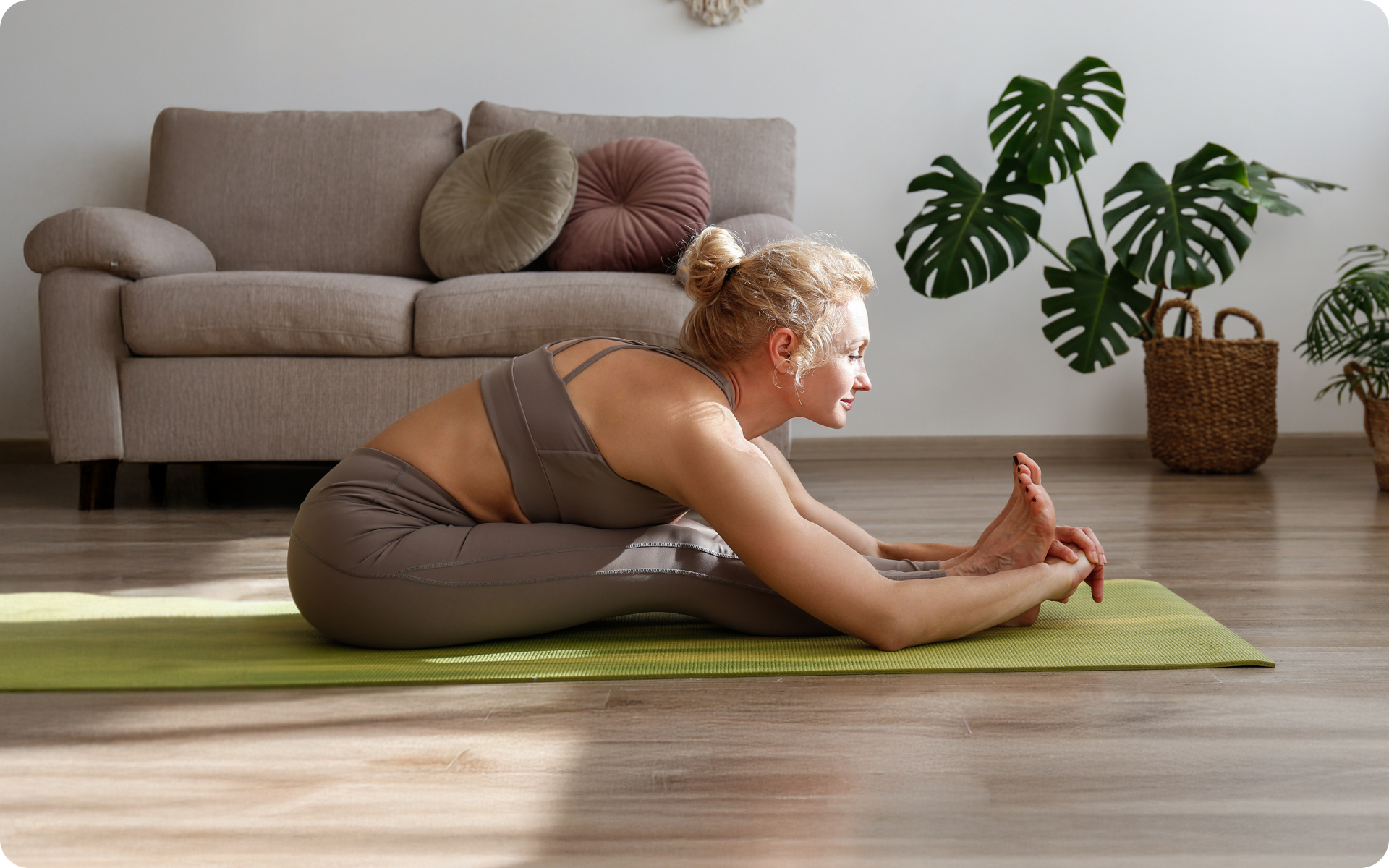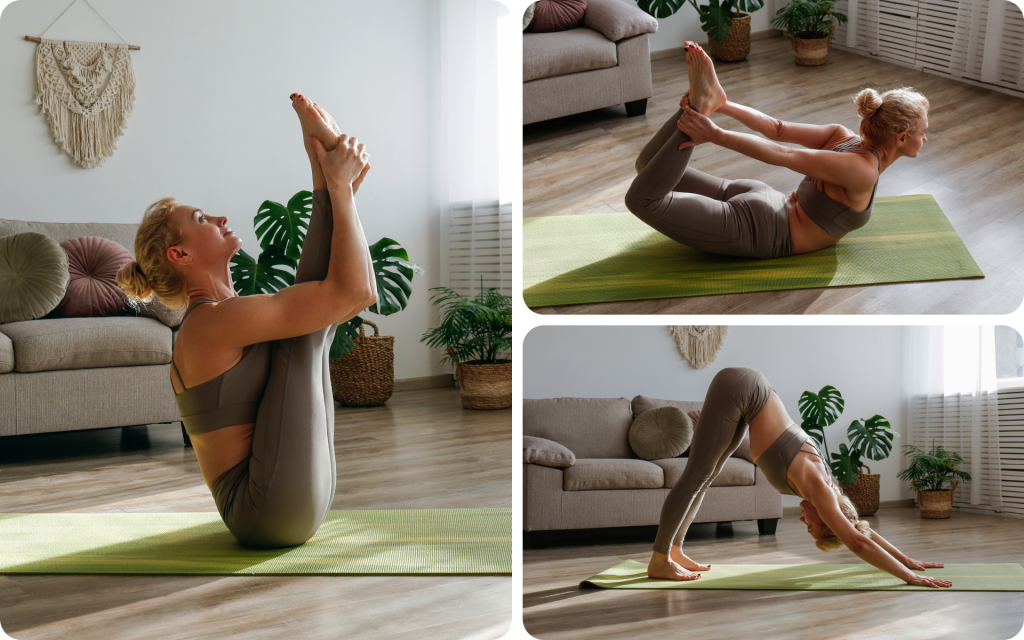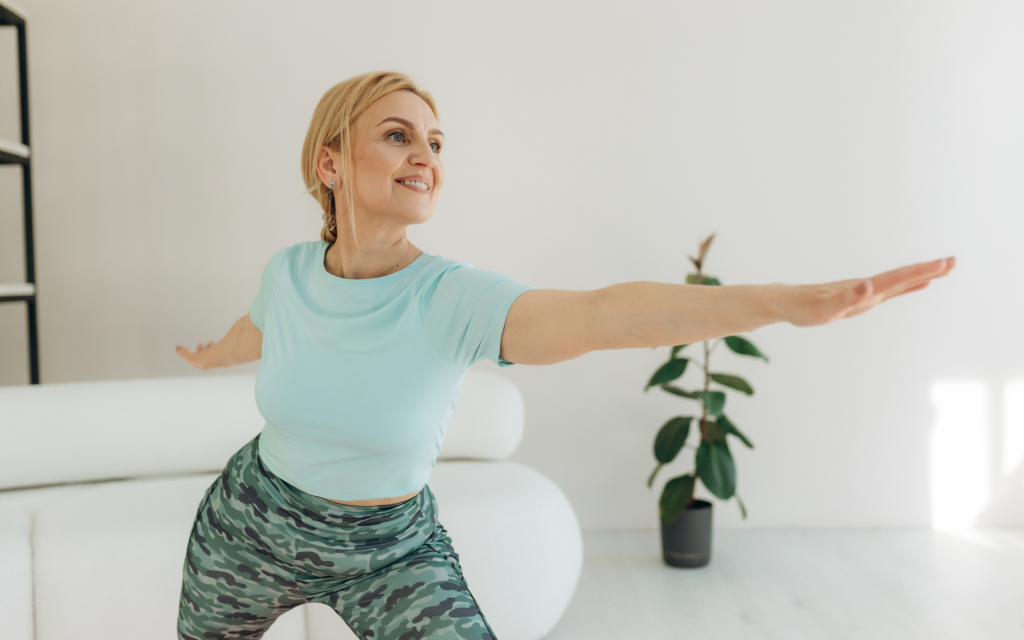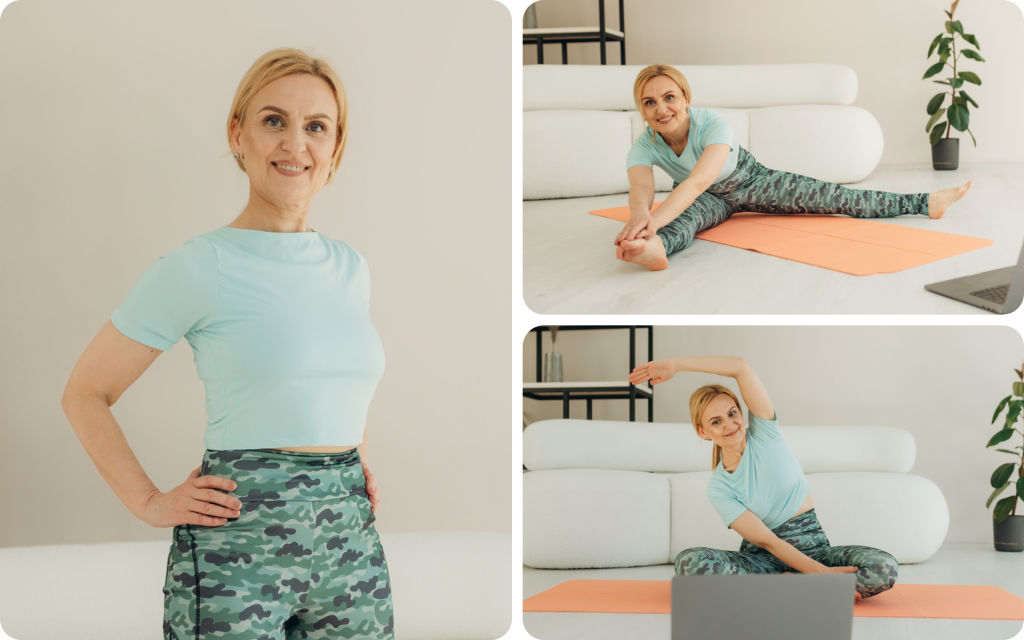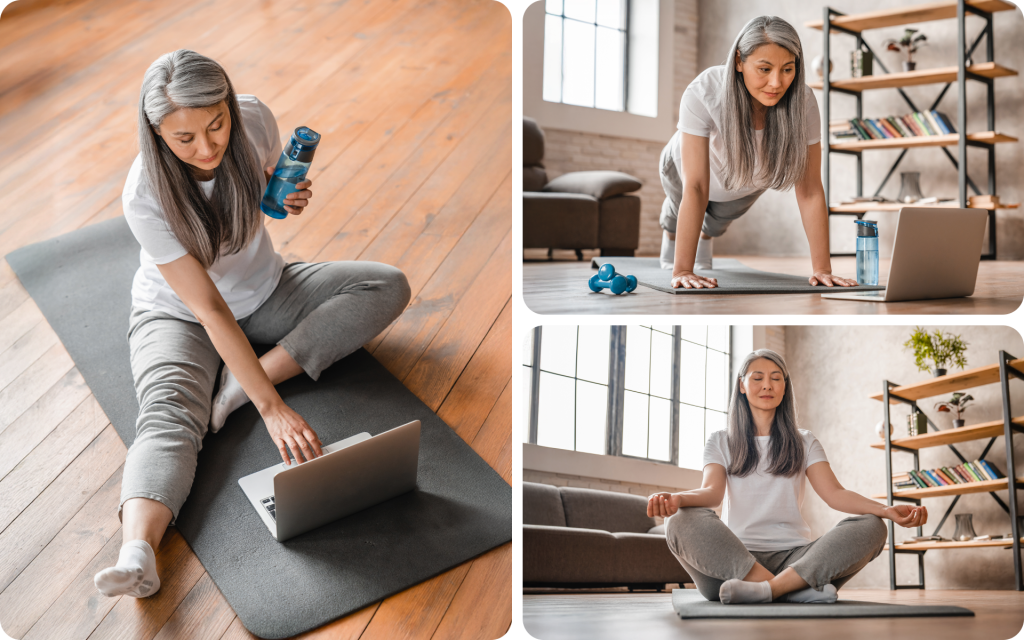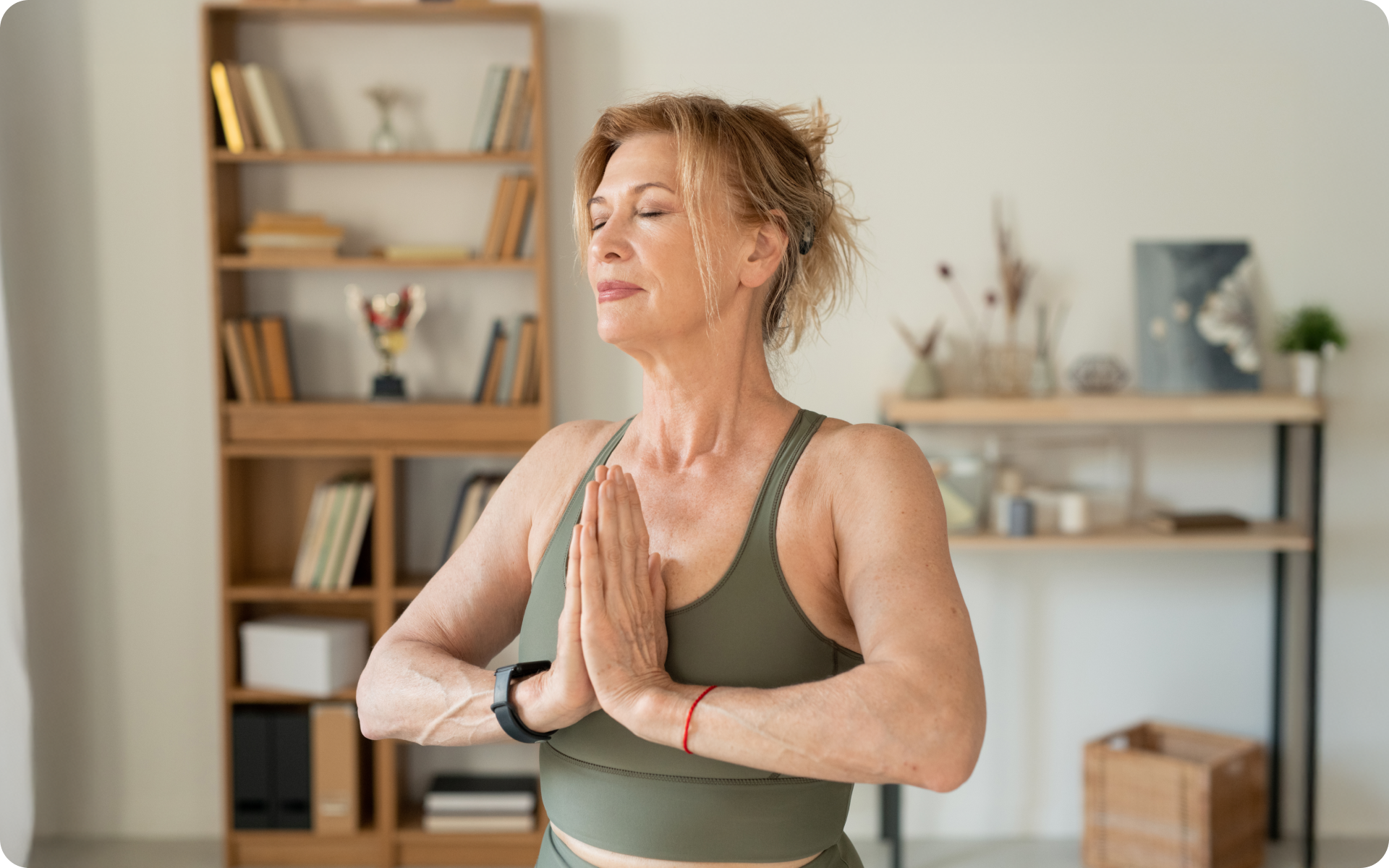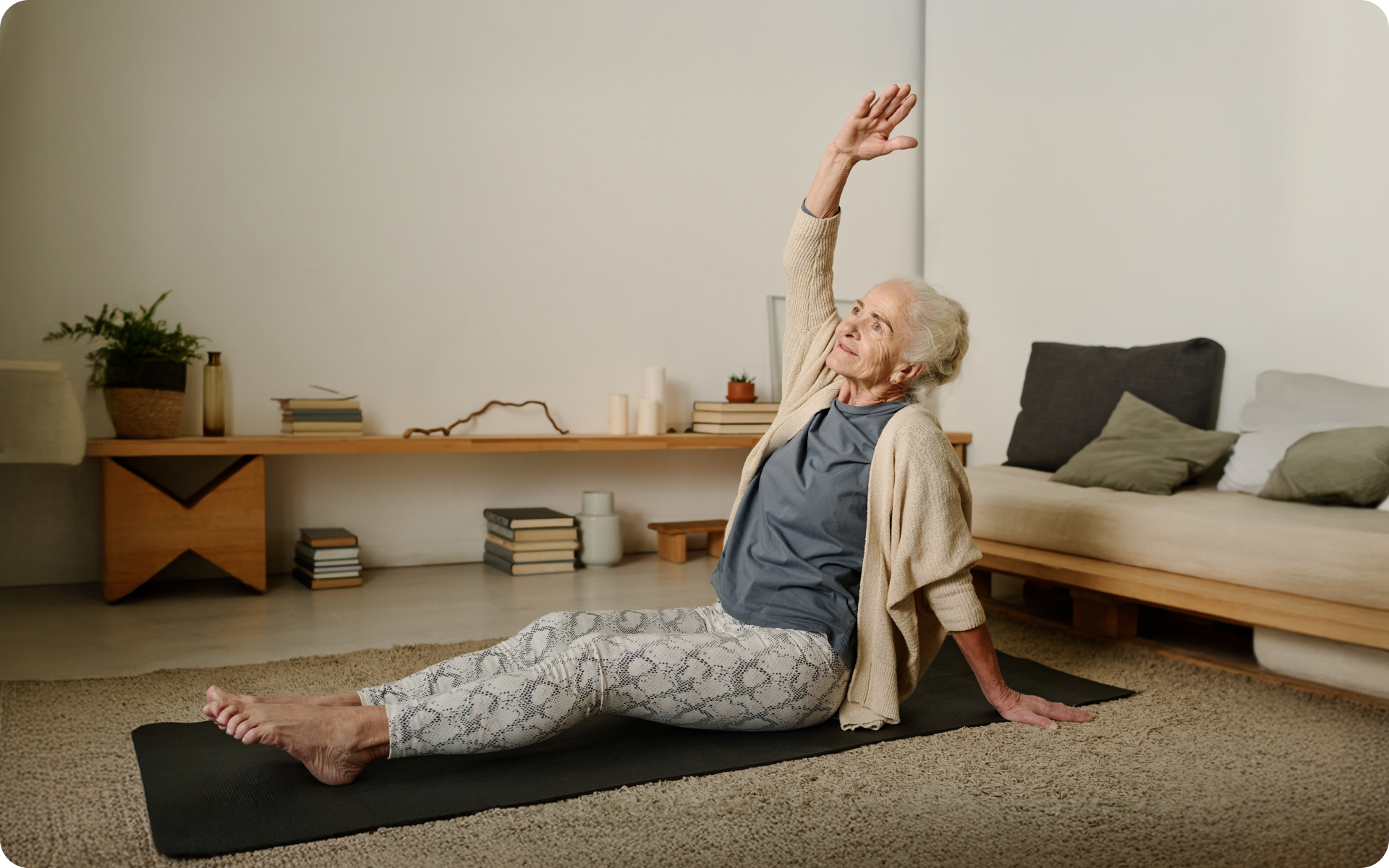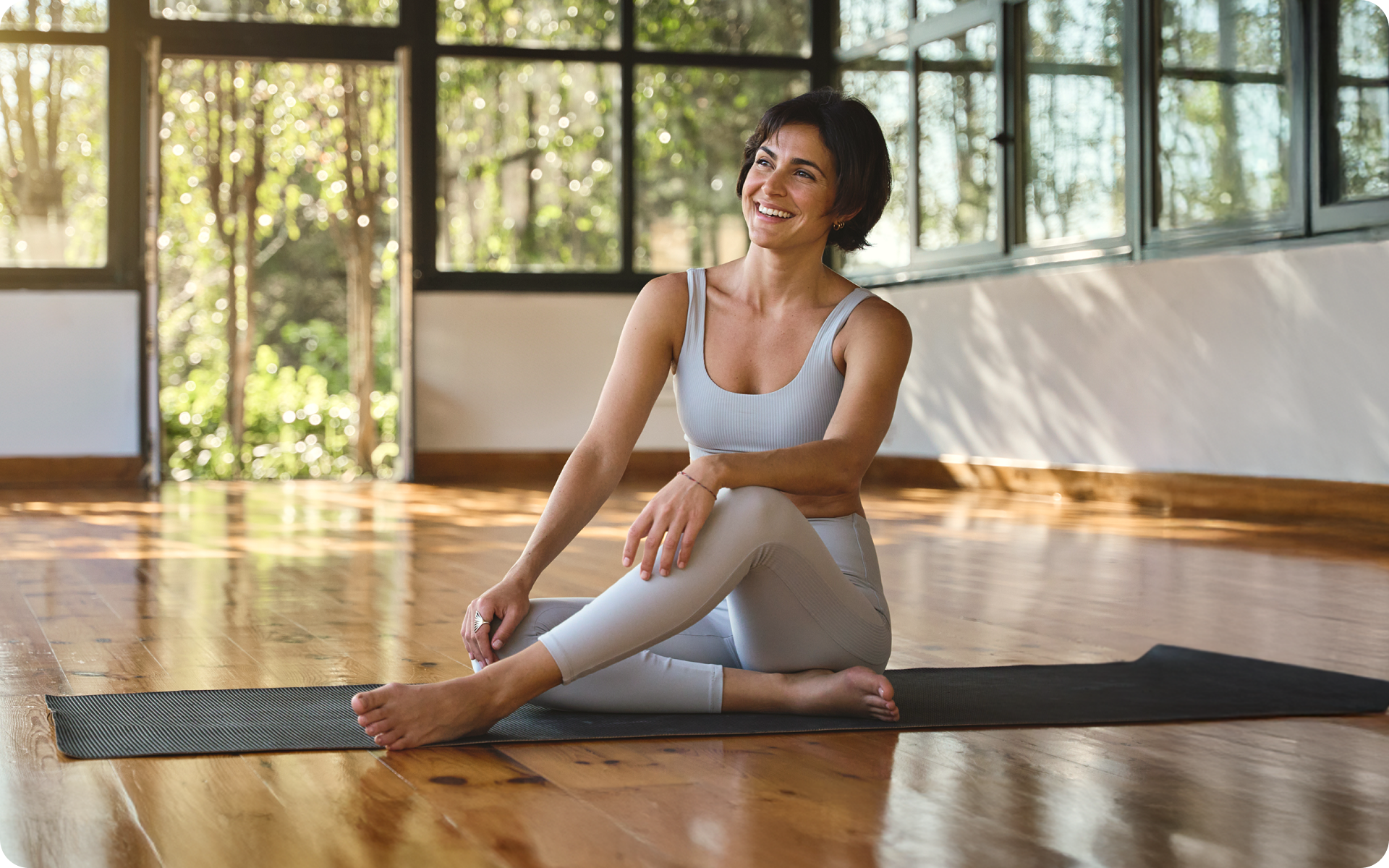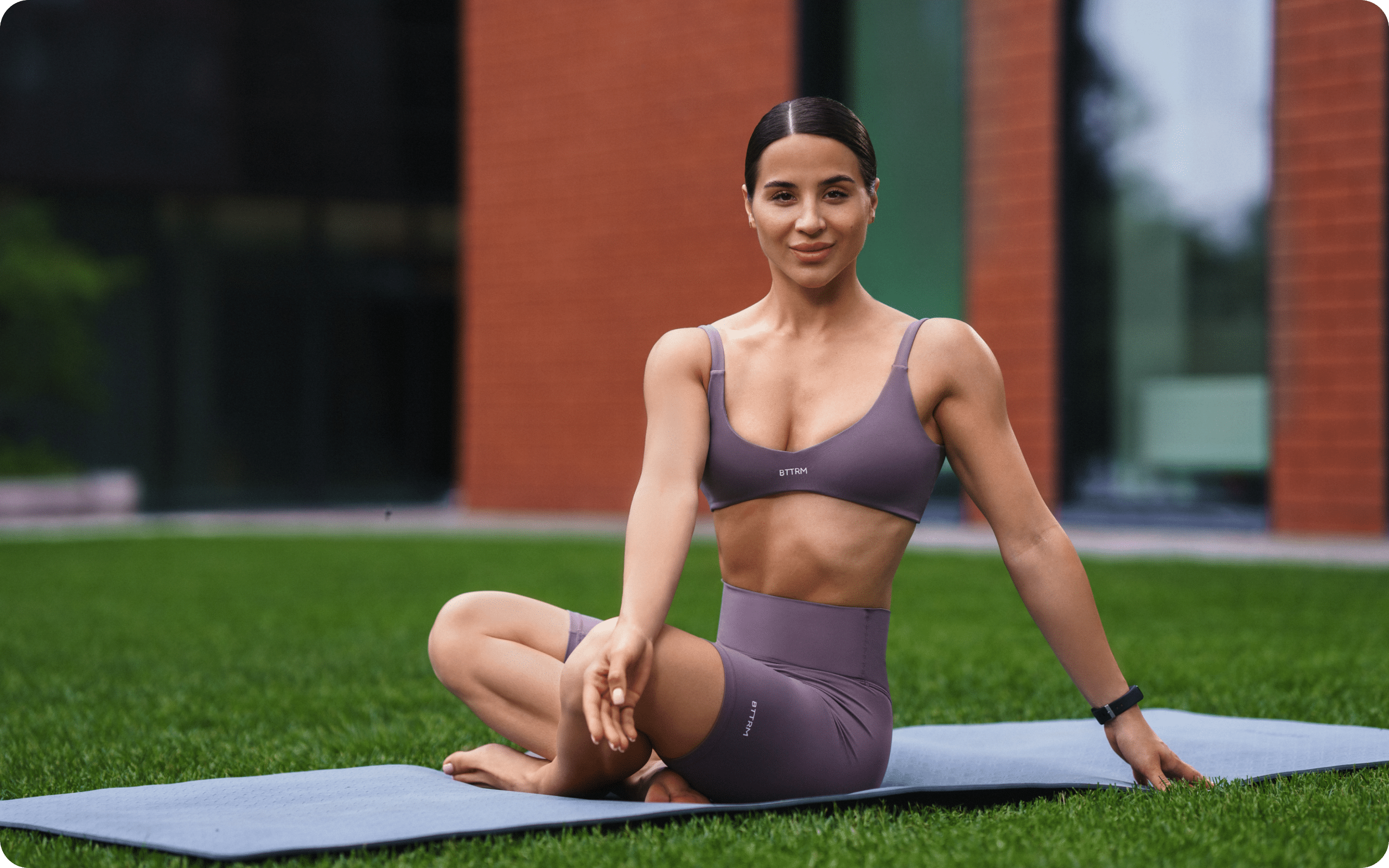Menopause can feel as if your body’s hitting you with plot twists you didn’t ask for – hot flashes, restless nights, and emotions all over the map. It’s a natural phase marking the end of your periods and a shift in hormones, but that doesn’t make it any less challenging. While every woman’s experience is different, one thing’s for sure: navigating these changes can be tough.
Typically occurring between ages 45 and 55, menopause brings a slew of symptoms that are caused by declining levels of estrogen and other hormones. The changes can be profound and finding effective ways to manage them is very important for improving your quality of life during this time.
This is where yoga comes in – a practice that dates back thousands of years and combines physical postures, breathing exercises, and meditation. What sets yoga apart from other forms of exercise is its focus on the mind-body connection. During menopause, yoga can help you manage stress, ease physical tension, and lift your mood. Whether you’re flowing through a series of poses or taking a few minutes to breathe deeply, yoga offers a way to reconnect with yourself when your body is going through major changes.
For many people, it’s more than just a physical workout – it’s a tool to foster resilience and find balance during a challenging time. Yoga encourages you to tap into your own power, one breath and pose at a time, making it a valuable companion on your menopause journey. It’s like hitting the reset button, one pose at a time.
In our article, we get into the details of yoga for menopause and all the benefits you can reap from it.
What’s the Best Natural Menopause Relief?
Managing menopause naturally often involves a multi-pronged approach that targets different symptoms. Hormone replacement therapy (HRT) is a common medical intervention, but many women prefer natural methods to minimize potential side effects and risks. Here’s what works for those seeking more holistic relief:
- Dietary Changes: Adding foods that are rich in phytoestrogens (such as soy, flaxseeds, and chickpeas) to your diet can naturally balance hormones and tone down hot flashes. Phytoestrogens are plant-based compounds with estrogen-like activity that may help reduce the frequency and intensity of these (5).
In addition, calcium and vitamin D are crucial for bone health, which often deteriorates during menopause due to lower estrogen levels. Dark leafy greens, dairy, and fortified foods can help support bone strength(5).
- Exercise: Consistent exercise isn’t just great for your body – it also helps stabilize your mood, improve sleep, and protect bone health. So go for that walk, try a dance class, or hit the gym. Cardiovascular workouts, strength training, and even low-impact activities such as walking can enhance overall fitness, support weight management, and improve heart health (6).
Weight-bearing exercises, such as jogging or dancing, also help maintain bone density. In addition, regular movement releases endorphins, the “feel-good” hormones, which help counter anxiety and depression(6). - Mind-Body Practices: Yoga, meditation, and deep breathing exercises can all lower stress hormone levels, promoting a calmer state of mind. This makes it easier to manage the stress, mood swings, and sleep disturbances that come with menopause (7).
- Herbal Supplements: Black cohosh, red clover, and evening primrose oil are popular herbal remedies for alleviating hot flashes, night sweats, and hormonal imbalances. However, before you stock up, remember: what works for one person may not work for everyone (8).
It’s important to consult a healthcare professional before taking any new supplements to avoid drug interactions and unwanted side effects.
Natural menopause relief often involves consistency and a personalized approach. Not every remedy works for everyone, but with patience and some experimentation, you can find the combination that works best for you.
Read more: Bend, Stretch, And Flow With Yoga Routines That Improve Flexibility
Does Yoga for Menopause Work?
In short, absolutely! Yoga can significantly improve quality of life during menopause by addressing both physical and emotional symptoms. Here’s how it works:
- Reducing Hot Flashes and Night Sweats: Multiple studies have found that women who practice yoga regularly experience fewer and less intense hot flashes. This is likely due to yoga’s ability to lower cortisol levels (the stress hormone), improve blood circulation, and regulate the autonomic nervous system, which can play a role in temperature regulation (9).
- Alleviating Mood Swings and Stress: Menopause is often associated with changes in mood, increased anxiety, and even depression. Yoga helps stabilize mood through mindful movement, meditation, and breath control, all of which lower stress and promote the release of feel-good neurotransmitters like serotonin and dopamine (9).
- Improving Sleep Quality: Insomnia and disrupted sleep are common during menopause. Regular yoga practice – particularly poses and routines that focus on deep relaxation – has been shown to improve both the quality and duration of sleep. Techniques such as Yoga Nidra, a form of guided meditation, can help promote restful sleep by calming the nervous system (9).
- Supporting Bone Health and Joint Mobility: As estrogen levels decline, bone density often decreases, putting menopausal women at a higher risk of osteoporosis. Weight-bearing yoga poses such as warrior I, tree pose, and triangle pose can strengthen bones and muscles, while also improving balance and flexibility, reducing the risk of falls (10).
Whether you’re looking to simply pep up your fitness routine, jazz up your diet with mouth-watering low-calorie recipes or want to get your act together and significantly drop that number on your scale – BetterMe: Health Coaching app has got you covered! Improve your body and revamp your life!
Can Yoga Help With Hormone Imbalance, and Which Type Is Best?
Hormonal imbalances during menopause can make life challenging, but yoga offers a gentle and natural way to support hormone regulation. Here’s why and what to practice:
-
- Restorative Yoga: Slow, gentle, and focused on deep relaxation – ideal for unwinding and calming those cortisol spikes (stress hormones).
-
Hatha Yoga: Finding Calm Through Movement and Breath
Hatha yoga is centered on gentle movement, mindful breathing, and longer-held postures, which makes it a strong tool for managing stress. This style is particularly useful for helping to reduce spikes in cortisol, the body’s primary stress hormone (11).
- Key Poses:
Postures such as Supta Baddha Konasana (reclining bound angle) and Viparita Karani (legs-up-the-wall) are often used to activate the parasympathetic nervous system, encouraging relaxation and calm. When practiced regularly, these poses may help buffer the body’s cortisol response, particularly during periods of chronic stress or hormonal shifts (12).
Yoga Poses for Menopause
Yoga can help you manage menopausal symptoms such as pain relief, stress, depression, and sleeping problems. In addition, it can reduce the effects of changes that are associated with aging, such as muscle loss and degenerating joints (4).
Your emotional well-being can also receive a boost from the reduction of the emotional symptoms of menopause. That being said, you need to understand that there are several different types of yoga exercises. Some help with fighting muscle tightness and others can improve flexibility.
Again, these exercises have countless modifications, which means that there are adaptations for every fitness level. Accounting for these factors can be overwhelming, which is why we’re here. We want you to use yoga to relieve menopausal pain and discomfort if your doctor has given you the OK.
We’ve compiled a list of the best yoga exercises for menopause here. We’ll discuss the menopausal discomfort or pain that each pose counteracts. Here are the exercises:
Lunge Pose
The lunge pose is known as Banarasana in Sanskrit. It’s one of the best stretching exercises for your hip flexors and psoas muscle (3). Two of the symptoms of menopause are shortness of breath and declined lung function.
This pose helps manage these symptoms by stretching your psoas muscle, which frees up your breath and tension in the body. Below is a look at the steps to perform the lunge pose:
- Start on your hands and knees.
- Step your left foot in front and in between your hands so the heel of your foot is aligned with the heels of both hands.
- Position your torso in an upright position and place your hands on your hips. Double-check to see that your knee is directly above your ankle and in a stacked position.
- Relax your shoulders, look straight ahead, and hold the move for a few seconds.
- Deepen the bend in your knee until you feel the hip flexor of your right leg stretch.
- Open your chest, take deep breaths, and alternate legs.
Boat Pose
Weight gain during perimenopause and early postmenopause is often driven by a mix of factors, including lower estrogen levels, a slowing metabolism, and shifts in lifestyle or health. Unfortunately, most of the weight settles in the belly and waistline. Belly fat is one of the weight issues most women face, regardless of whether or not they are in menopause.
Luckily, there are exercises you can perform to shed this unwanted fat. For menopausal women, one of the best moves in yoga for menopause belly is the boat pose. It targets your core muscles while strengthening your hip flexors and adductor muscles (3).
This also fights tightness in the hamstrings, which is associated with injury risk. Here are the steps to follow to perform the boat pose (3):
- Sit on the floor and stretch your legs in front of you.
- Press your hands on the floor and slightly behind your hips and lift through the top of the sternum. Make sure to lean back slightly and not arch your back. Similarly, make sure the weight of your body is felt on your sitting bones and tailbone.
- Breathe out, bend your knees, and lift your thighs off the floor to a 45-degree angle with your knees still bent.
- Slowly straighten your knees if you can and raise your toes slightly above your eye level. Keep your knees bent and your shins parallel to the floor if you cannot do this.
- Keep your chest open, spine long, shoulders back, and both arms in front and alongside your legs but parallel to the floor. Make sure your palms are facing in and that you keep your lower belly flat and firm.
- Flex your toes through your heels and take deep breaths. Hold this pose for 10 to 20 seconds and slowly increase the timeline if you can.
- Slowly lower your legs to the starting position and repeat two to three times.
You can also perform this movement using a yoga ball. If you choose to follow this technique, here are the steps to follow (3):
- Start in a sitting position, with a yoga ball in front of your body.
- Bring your knees close to your chest.
- Breathe in and engage your abdominal muscles.
- Lean back onto the sacrum and start lifting your arms with the ball in your hands.
- Slowly stretch your legs to a 45-degree angle with the floor.
- Pause and hold the pose for 5 to 10 breaths.
- Breathe in, roll forward, lower your arms, and press your feet on the mat.
- Repeat two to three times.
Chair Pose
The chair pose is also referred to as the Utkatasana pose in Sanskrit. It’s a powerful and strengthening pose that brings all your body muscles together to work cohesively and as a whole. However, it primarily strengthens your thighs, ankles, and core.
The move also improves your balance and enhances your resilience. Here’s a guide on how to perform this move (2):
- Start in a standing position with your feet slightly wider than hip-width apart and your arms by your sides.
- Breathe in and raise your arms overhead so your biceps are slightly in front of your ears. Keep your arms parallel and your palms facing inward. Keep your shoulders down and your back straight.
- Breathe out and bend your knees, keeping your thighs parallel to the floor. It will make your trunk lean slightly forward and over your thighs to create a 90-degree angle with the tops of your thighs.
- Align your neck and head with your arms and torso and hold the stretch for 30 to 60 seconds.
- Return to the standing position by straightening your knees with an inhalation and repeat two to three times.
Cat-Cow Pose
The cat-cow pose, also known as Chakravakasana yoga stretch, is an essential move in menopausal women and for good reason. It targets your spine and abdominals and involves moving your spine in a rounded position and then to an arched one.
Experts have revealed that this pose massages the tissues and joints around your spine that dry out with aging (2). This exercise keeps them soft and provides comfort to achy joints during menopause. It also improves balance and is an excellent supporting pose if you feel overwhelmed. Here’s a step-by-step guide on how to perform this pose:
- Start on your hands and feet and position your wrists directly under your shoulders and your knees beneath your hips.
- Keep your back straight from the crown of your head to your tailbone. Similarly, keep your neck long by looking down and out.
The Cow Pose
You will start by performing the cow pose, and here are the steps to follow to nail this pose (2):
- Press down firmly on the mat using your hands.
- Breathe in and arch your back slowly by lowering your belly. At the same time, lift your chin and sternum and broaden your collarbones.
- Keep the back of your neck long and your abdominal muscles slightly toned to obtain more movement in your mid- and upper back.
- Hold for a few seconds before releasing the pose by maintaining a neutral spine.
The Cat Pose
You will end with the cat pose, which you will achieve by executing these steps (2):
- Curl your toes under and press down by firmly resting your hands on the floor.
- Breathe out and round your spine as if lifting it toward the ceiling. Make sure you drop the crown of your head and tailbone and lower your belly in and up. However, make sure to keep your core muscles hugging your spine and your navel drawn in.
- Push the floor using your hands to extend the distance across your shoulder blades.
- Position your hips over your knees and keep your arms straight to maintain movement in your spine.
- Release the pose by returning your spine to a neutral position.
Downward Facing Dog
The downward-facing dog pose, also known as Adho Mukha Svanasana, targets your hamstrings and calves (1). It can be performed as a transitional pose or a resting stance. It’s considered an excellent pose for menopausal women as it alleviates menopause symptoms.
For example, it stretches your leg muscles and upper back, fights fatigue, and strengthens your arm muscles, preventing osteoporosis risk. Similarly, it allows for blood circulation to the brain, which enhances a state of calm. Here are steps to follow to attain this pose (1):
- Start in a standing position, but then come to your hands and knees by positioning your wrists beneath your shoulders and your knees under your hips.
- Curl your toes under and push back through your hands to slowly lift your hips and stretch your legs.
- Spread your fingers on the floor and rotate your upper arms outward to extend your collarbones.
- Let your head hang and position your shoulder blades away from your ears toward your hips.
- Take the weight off your arms by engaging your quads, which brings you to a resting pose.
- Rotate your thighs inward, keep your tailbone high, and sink your heels toward the floor.
- Make sure the distance between your hands and feet is the same through both poses and that you don’t lift your heels off the floor during the stretch.
- Breathe out and bend your knees to release and return to your hands and knees.
- Return and perform the move at least three times.
The Child’s Pose
The child’s pose is recommended for women who are going through menopause due to its soothing effects. It reduces tension by stretching your spine and hips and calms your mind when you feel overwhelmed. It also promotes better sleep, which is difficult to come by for menopausal women, particularly those who are battling hot flashes and night sweats (2). You can try it by following these steps (2):
- Start by kneeling on your mat and open your knees to the sides. Make sure your big toes are touching each other.
- Position a bolster, such as a cushion or a pillow, between your legs and gently fold forward. Rest the front part of your body on the cushion or pillow and relax your arms on the floor. Breathe deeply and generally as you turn your head to one side.
- Alternatively, you can place the pillow on your back and your shoulders over your head for a few minutes. Stay in this position for 5 to 10 minutes, during which you’re required to breathe normally and turn your head to the other side halfway through the move.
- To release the stretch, press your hands into the floor and lift your chest so you sit upright.
Warrior II Pose
The other excellent yoga move for menopausal women is the warrior II pose. It stretches your back, hips, ankles, and legs and improves balance and stability. In addition, the pose effectively fights fatigue that is often linked to menopause by increasing blood circulation. Here is a detailed guide on how to achieve this pose (1):
- Start in a standing position and face the direction of the long side of your mat. Stretch your arms to the sides and keep your feet parallel to each other and slightly wider than hip-width apart. At the same time, make sure to keep your feet at least beneath your hands.
- Turn your right foot and knee toward the front part of the mat.
- Position your left toes slightly toward your right foot and align your right heel with your left inner arch.
- Bend your right knee and stack it over the ankle.
- Press your left thigh bone back and release your tailbone down.
- Make sure you keep the crown of your head over your pelvis and your shoulders over your hips.
- Stretch both arms fully in front and at the back of the mat, and turn to look past your right fingers.
- Stay in this position for a few breaths or minutes.
- To release the stretch, press firmly down through your feet and exhale, followed by inhalation as you straighten your legs and position them in the initial position, which is parallel to the left long side of the mat.
- Do the same on the other side.
How to Practice Yoga for Menopause Safely
Whether you’re doing yoga in the menopause or perimenopause phase, the idea is to perform it safely and minimize injury risk. Here are some expert-recommended tips to help you practice yoga safely (2):
- Learn the Correct Form
It’s always best to learn the correct technique of a pose, and if possible, with the help of a licensed instructor or yogi. Remember that wrong form is a contributing factor to injury risk.
- Listen to Your Body
It’s best to listen to your body and abide by its signals. If you experience pain, extreme fatigue, or discomfort, stop doing the pose. You don’t have to complete all the reps or sets for the routine. Instead of such an approach, focus on quality over quantity.
- Warm-up
Unfortunately, most people forget to warm up before they perform a yoga regime. A warm-up session is vital as it prepares your body for the upcoming routine by fighting muscle stiffness. With this in mind, try to perform gentle warm-up exercises such as shoulder rolls or neck stretches.
Want to spring-clean your diet, skyrocket your self-confidence, and shatter your insecurities? Check out the BetterMe: Health Coaching app and set this plan in motion!
- Seek Support
It’s best if you seek support when you need it. For example, if a move requires you to use a chair for extra stability, please use it. It makes the stretch more manageable to achieve and takes away tension and strain from your body.
- Challenge Yourself
With time, you’re urged to challenge yourself by increasing the intensity of several exercises. Once your instructor or yogi agrees, you can accomplish this by increasing either the reps or sets of the activities. However, remember that the idea is to challenge yourself without strain.
- Have Fun
Yoga is one of the most fun activities to perform. Let loose and enjoy the moment. Experts reveal that you can increase the fun meter when doing yoga by not seeing it as a punishment or competition. Instead, let loose and view it as a fun activity.
Similarly, listen to some music if possible. There’s a saying that music is the cure to the soul, and true to its word, music does have calming effects that help you forget fatigue and keep you relaxed through your regime.
- Don’t Skip the Basics
It would be best to start with the beginner modifications before progressing to those of advanced and intermediate levels. This approach minimizes injury risk.
Read more: 3 Yoga Sequences For Beginners To Try At Home
Is Pilates or Yoga Better for Menopause?
Both yoga and Pilates offer distinct benefits, but which is “better” really depends on your needs:
- Yoga: Ideal for those who want to focus on flexibility, mindfulness, stress reduction, and overall balance. Yoga is excellent for managing mood swings, alleviating anxiety, and promoting better sleep, which makes it a popular choice for menopausal women who are looking for emotional and physical relief.
- Pilates: This style of workout focuses on core strength, stability, and muscle toning. It’s particularly beneficial during menopause for improving posture and protecting bone health, as many Pilates exercises are weight-bearing – an important factor in maintaining bone density and reducing the risk of osteoporosis (13).
For the best results, consider incorporating both into your routine. They complement each other beautifully, offering a holistic approach to navigating menopause with strength and ease.
Other Lifestyle Tips on Dealing with Menopause
In addition to doing yoga, you could make several lifestyle changes to better manage your menopause symptoms. Some of these include (2), (1):
- Performing relaxation and deep breathing exercises for stress relief, such as belly breathing.
- Limiting or quitting smoking and contact with secondhand smoke.
- Limiting or avoiding alcohol entirely.
- Consuming a healthy diet rich in fresh fruits, vegetables, and whole grains.
- Creating and sustaining good sleeping habits allows you to get plenty of quality rest.
- Performing kegel exercises to strengthen your pelvic floor.
- Talking things out with your family or friends, particularly those who have experienced or are experiencing menopause.
- Taking up a new hobby, doing volunteer work, or joining a club that keeps you busy and on your toes.
- Exploring new ways of sparking flames in your sexual relationship with your partner.
No, but it can alleviate stress and promote improved mental health. Herbal teas such as chamomile, green tea, and black cohosh tea may ease menopausal symptoms. In addition, soy milk and flaxseed-rich smoothies can provide phytoestrogens that may benefit estrogen levels. Weight-bearing exercise is highly anti-aging as it preserves muscle mass, boosts metabolism, and supports bone density, which serves to combat age-related decline. Combining it with aerobic exercise such as brisk walking further enhances cardiovascular health and longevity.Frequently Asked Questions
Can yoga increase estrogen levels?
What drink is good for menopause?
Which exercise is the most anti-aging?
” mp4=”https://cdn.betterme.world/articles/wp-content/uploads/2025/05/Beginner-Yoga-2.mp4″]
The Bottom Line
Yoga can be used to manage menopausal symptoms, including pain, stress, and fatigue. You can also perform some yoga poses to fight the belly fat that forms during menopause. Some of the recommended yoga asanas for menopause include the chair pose, cat and cow, warrior II, boat, lunge, and downward-facing dog.
It would be best to seek the guidance of a yogi or instructor to learn the correct technique and minimize injury risk. At the same time, listen to your body and start with the basics. These expert-approved tricks should make this transition more manageable.
DISCLAIMER:
This article is intended for general informational purposes only and does not serve to address individual circumstances. It is not a substitute for professional advice or help and should not be relied on for making any kind of decision-making. Any action taken as a direct or indirect result of the information in this article is entirely at your own risk and is your sole responsibility.
BetterMe, its content staff, and its medical advisors accept no responsibility for inaccuracies, errors, misstatements, inconsistencies, or omissions and specifically disclaim any liability, loss or risk, personal, professional or otherwise, which may be incurred as a consequence, directly or indirectly, of the use and/or application of any content.
You should always seek the advice of your physician or other qualified health provider with any questions you may have regarding a medical condition or your specific situation. Never disregard professional medical advice or delay seeking it because of BetterMe content. If you suspect or think you may have a medical emergency, call your doctor.
SOURCES:
- A 31-day yoga routine to help you reduce stress (2019, nbcnews.com)
- Beat Stress With Yoga (2021, webmd.com)
- How does yoga affect the body, and how can someone start practicing yoga? (2021, medicalnewstoday.com)
- Menopause (2022, mayoclinic.org)
- Managing menopause with diet (n.d., nutrition.org.uk)
- Twelve-week exercise training and the quality of life in menopausal women (2016, pmc.ncbi.nlm.nih.gov)
- The Effect of Breathing Exercise on Stress Hormones (2020, cyprusmedsci.com)
- A comparative study on the effect of “black cohosh” and “evening primrose oil” on menopausal hot flashes (2018, ncbi.nlm.nih.gov)
- Yoga and menopausal transition (2010, pmc.ncbi.nlm.nih.gov)
- Effects of Yogasanas on osteoporosis in postmenopausal women (2016, ncbi.nlm.nih.gov)
- The influence of hatha yoga on stress, anxiety, and suppression: A randomized controlled trial ( 2023, sciencedirect.com)
- Effect of long-term yoga training on autonomic function among healthy adults (2022, pmc.ncbi.nlm.nih.gov)
- Effectiveness of Pilates and Yoga to improve bone density in adult women: A systematic review and meta-analysis (2021, pmc.ncbi.nlm.nih.gov)

